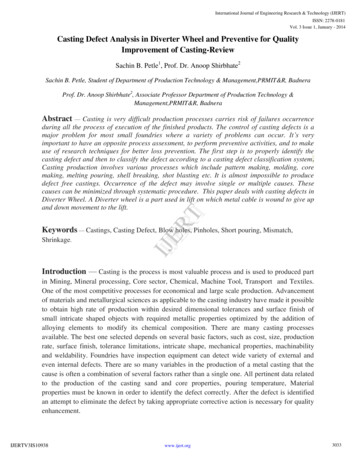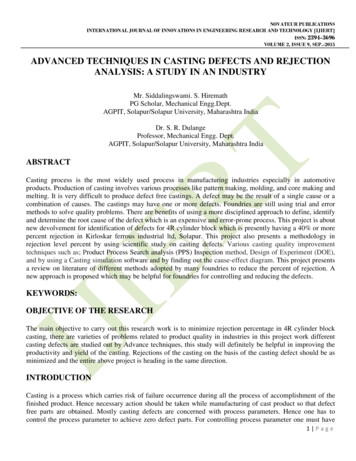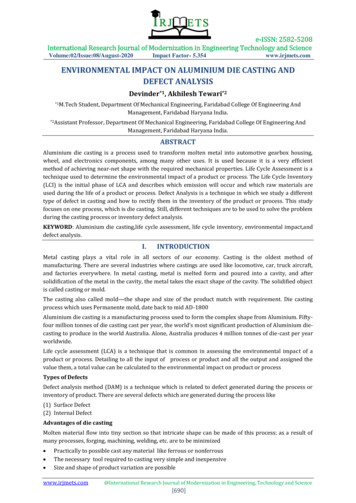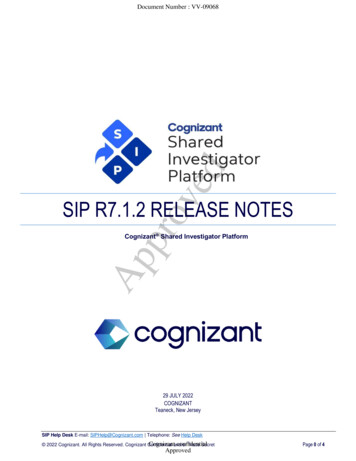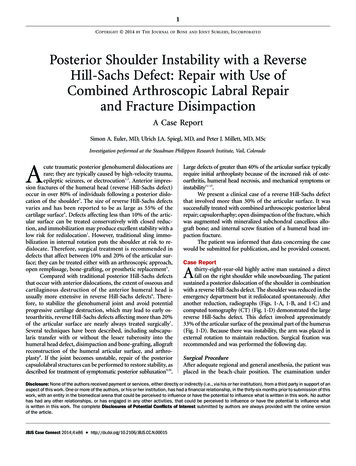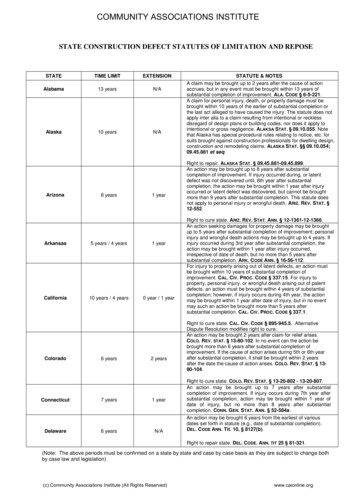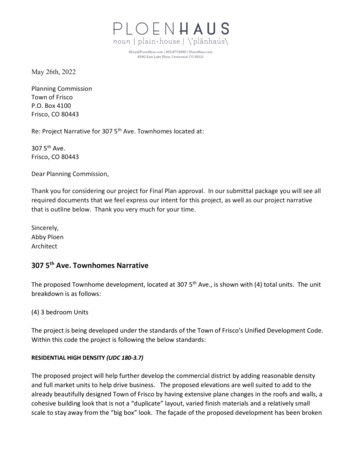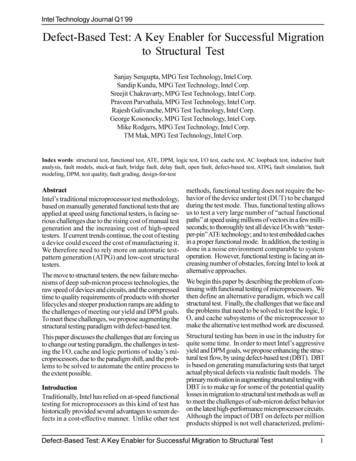
Transcription
International Journal of Pure and Applied MathematicsVolume 118 No. 20 2018, 3863-3873ISSN: 1314-3395 (on-line version)url: http://www.ijpam.euSpecial Issueijpam.euOverview of Software Defect Prediction using Machine Learning AlgorithmsN.Kalaivani1, Dr.R.Beena21Associate Professor,Department ofComputer Science,Kongunadu Arts and Science College,Coimbatore – 641029,Tamilnadu.e-mail: kalaivhani@gmail.com2Associate Professor and Head,Department of Computer ScienceKongunadu Arts and Science College,Coimbatore – stractSoftware Defect Prediction [SDP] plays an important role in the active research areas of softwareengineering. A software defect is an error, bug, flaw, fault, malfunction or mistake in softwarethat causes it to create a wrong or unexpected outcome. The major risk factors related with asoftware defect which is not detected during the early phase of software development are time,quality, cost, effort and wastage of resources. Defects may occur in any phase of softwaredevelopment. Booming software companies focus concentration on software quality, particularlyduring the early phase of the software development .Thus the key objective of any organization isto determine and correct the defects in an early phase of Software Development Life Cycle[SDLC]. To improve the quality of software, datamining techniques have been applied to buildpredictions regarding the failure of software components by exploiting past data of softwarecomponents and their defects. This paper reviewed the state of art in the field of software defectmanagement and prediction, and offered datamining techniques in brief.Keywords: Software defect prediction, data mining, machine leaning.1. Software Defect Prediction1.1Software DefectA software defect is an error, bug, flaw, fault, malfunction or mistakes in software that causes itto create an erroneous or unpredicted outcome. Faults are essential properties of a system. Theyappear from design or manufacture, or external environment. Software flaws are programmingerrors which cause different performance compared with anticipation. The majorities of thefaults are from source code or deign, some of them are from the incorrect code generating fromcompilers.For software developers and clients, software faults are a danger problem. Software defects notmerely decrease software quality, increase costing but also delay the development schedule.Software fault predicting is proposed to solve this sort of trouble. SDP can efficiently progress13863
International Journal of Pure and Applied MathematicsSpecial Issuethe effectiveness of software testing and direct the allocation of resources. To develop qualitysoftware, software flaws have to be detected and corrected at early phase of SDLC.1.2Software Defect ManagementThe main aim of software defect management is to amplify the quality of software by identifyingand fixing the defects in the early phase of SDLC. The various phases of SDLC are requirementsgathering phase, analysis phase, designing phase, coding phase, testing phase, implementationand maintenance phase. SDP plays a vital role in developing high quality software. Identifyingthe defects in an preliminary stage of a SDLC is a very complicated job, hence efficient methodsto be applied in order to remove them.The main stages in defect handling includes [1]: Identifying the defectsCategorizing the defectsAnalyzing the defectsPredicting the defectsRemoving the defectsThe first step is to identify the occurrence of defects in software. Code inspection, building aprototyping model and testing are used to identify the defects in software. After identifying thedefects, the defects should be categorized, analyzed, predicted and detected.1.3Software Defect Prediction [SDP]SDP identifies the module that are defective and it requires wide range of testing. Earlyidentification of an error leads to effective allocation of resources, reduces the time and cost ofdeveloping a software and high quality software. Therefore, an SDP model plays a vital role inunderstanding, evaluating and improving the quality of a software system.2. Related WorkPeng He et al. conducted an empirical study on software defect prediction with a simplifiedmetric set [2]. Research has been conducted on 34 releases of 10 open source projects availableat PROMISE repository. The finding indicates the result of top-k metrics or minimum metricsubset provides acceptable output compared with benchmark predictors. The simplified orminimum mertic set works well in case of minimum resources.Grishma BR et al. investigated root cause for fault prediction by applying clustering techniquesand identifies the defects occurs in various phases of SDLC. In this research they usedCOQUALMO prediction model to predict the fault in a software and applied various clusteringalgorithms like k-means, agglomerative clustering, COBWEB, density based scan, expectationmaximization and farthest first. Implementation was done using Weka tool. Finally theyconclude that k-means algorithm works better when compared with other algorithms [1].Anuradha Chug et al. used three supervised [classification] learning algorithms and threeunsupervised [clustering] learning algorithms for predicting defects in software. NASA MDP23864
International Journal of Pure and Applied MathematicsSpecial Issuedatasets were run by using Weka tool. Several measures like recall and f-measure are used toevaluate the performance of both classification and clustering algorithms. By analyzing differentclassification algorithms Random Forest has the highest accuracy of MC1 dataset and also yieldshighest value in recall, f-measure and receiver operating characteristic [ROC] curve and itindicates minimum number of root mean square errors in all circumstances. In an unsupervisedalgorithm k-means has the lowest number of incorrect clustered instances and it takes minimumtime for predicting faults [3].Jaechang Name et al. applied Hetrogeneous Defect Prediction [HDP] to predict defects in with-inand across projects with different datasets. Metric selection, metrics matching and building aprediction model are the 3 methods used in this work. In this research they used various datasetsfrom NASA, PROMISE, AEEEM, MORPH and SOFTLAB. Source and target datasets are usedwith different metric sets. For selecting metrics feature selection techniques such as gain ratio,chi-square, relief-F and significance attribute selection are applied to the source. To matchsource and target metrics various analyzers like Percentile based Matching (PAnalyzer),Kolmogorov – Smirnov test based matchiong (KSAnalyzer), Spearman’s Correlation basedMatching (SCOAnalyzer) are used. Cutoff threshold value is applied to all pair scores and poorlymatched metrics are removed by comparison. Area Under the Receiver Operator CharacteristicCurve [AUC] measure is used to compare the performance between different models. HDP iscompared with 3 baselines – WPDP, CPDP-CM, CPDP-IFS by applying win/loss/tie evaluation.The experiments are repeated for 1000 times and Wilcoxon signed rank test (P 0.05) is appliedfor all AUC values and baselines. Performance is measured by counting the total number ofwin/loss/tie. When a cutoff threshold value gets increased in PAnalyzer and KSAnalyzer, theresults (win) also gets increased. Logistic Regression (LR) model works better when there is alinear relationship between a predictor and bug-prone [4].Logan Perreault et al. applied classification algorithm such as naïve bayes, neural networks,support vector machine, linear regression, K-nearest neighbor to detect and predict defects. Theauthors used NASA and tera PROMISE datasets. To measure the performance they usedaccuracy and f1 measure with clearly well defined metrics such as McCabe Metrics and HalsteadMetrics. 10-fold cross validation is used in which 90% of data are used for training and 10% ofdata are used for testing. ANOVA and tukey test was done for 5 dataset and 5 response variables.0.05 is set as significance level for PC1, PC2, PC4 and PC5 dataset and 0.1 as PC3 dataset.Weka tool is used for implementation. Implementations of these 5 algorithms are available onGithub repository. Finally the authors conclude that all datasets are similar and they are writtenin C or C and in future the work can be extended by selecting the datasets that are written inJava and instead of using weka tool for implementation some other tool can also be used [5].Ebubeogu et al. employed predictor variables like defect density, defect velocity and defectintroduction time which are derived from defect acceleration and used to predict the total numberof defects in a software. MAChine – Learning – Inspired [MACLI] approach is used forpredicting defects. The proposed framework for defect prediction has two phases. 1) Data preprocessing phase. 2) Data analysis phase [6].33865
International Journal of Pure and Applied MathematicsSpecial IssueRayleigh distribution curve is a proposed modeling technique used to identify predictor variablesand indicates the number of defects involved in developing SDLC. Simple linear regressionmodel and multiple linear regression models are used to predict the number of defects insoftware. The authors conclude that defect velocity performed best in predicting the number ofdefects with the strongest correlation co-efficient of 0.98.Yongli et al. applied data filters to datasets in order to increase the performance of CPDP. In thisresearch the authors proposed Hierarchical Select-Based Filter [HSBF] strategy. HSBF is basedon hierarchical data selection from software project level to software module level. Max value,min value, mean value and standard deviation are the four indicators which are merged togetherto represent the distributional characteristic of a given project. To correct the inconsistencies insoftware metrics between projects, cosine distance is applied. In this study, PROMISE datasetsand Confusion matrix are used to evaluate the performance measure. Due to imbalanced datasetprobability of detection [pd], probability of false alarm [pf] and AUC are also applied to measurethe performance. Therefore the authors conclude from the experiments, Naïve Bayes [NB]algorithm performs better than Support Vector Machine. For smaller projects Target - ProjectData Guided Filter [TGF] is used and for larger projects Hierarchical Select Based Filter [HSBF]is used for data selection from multi-source projects [7].Xiao Yu et al. build a prediction model for Cross Company Defect Prediction [CCDP] byapplying six imbalance learning methods such as under sampling techniques (random undersampling and near miss), over sampling techniques [SMOTE and ADASYN] and oversamplingfollowed by under sampling [SMOTE Limks, TOMEK, SMOTE ENN] [8]. PROMISE datasetsand classification algorithms such as NB, Random Forest [RF] and Linear Regression [LR] areapplied. Probability of detection, probability of false alarm and g-measure are used to measurethe performance. The authors conclude that NB performs better in predicting defects and it has ahigh pf value. Under sampling method works better with g-measure.Shamsul Huda et al. [9] studied that developing a defect prediction model by using more numberof metrics is a tedious process. So that a subset of metrics can be determined and selected. In thisresearch two novel hybrid SDP models such as wrappers and filters are used for identifying themetrics. These two models combine the training of metric selection and fault prediction as asingle process. In this research different datasets and classification algorithms such as SupportVector Machine [SVM] and artificial neural network are used. Performance was measured byusing AUC and MEWMA (Multivariate Exponentially Weighted Moving Average),implementation was done by using liblinear tool and mine tool.Gopi Krishnan et al. applied regression models to build a defect classifier. In this work teraPROMISE defect datasets and machine learning algorithms such as Linear/Logistic Regression,RF, K-Nearest Neighbour, SVM, CART and Neural Networks are used to build a predictionmodel. Two defect classifiers are developed namely discretized defect classifier and regressionbased defect classifier. In this work AUC is applied to evaluate the performance of a model andthe authors conclude that there is a loss of information in discretized classifier. Regression-basedclassifier uses continuous defect counts as the target variable for determining a defect module.43866
International Journal of Pure and Applied MathematicsSpecial IssueXinli Yang et al. proposed TLEL [Two Layer Ensemble Learning] to predict defects at changelevel. The advantages of ensemble methods are: Better performance can be achieved compared with single classifier.Combines bagging and stacking methods.TLEL has two layers namely inner layer and outer layer. In an inner layer, decision tress andbagging are merged to develop a random forest model. In an outer layer, random under samplingis used to train various random forest models and stacking is used to train ensemble techniques.TLEL is compared with 3 baseline methods such as deeper, DNC and MKEL. Performance ismeasured by using cost effectiveness and F1-Score.3. Approaches to Software Defect Prediction.Mostly three approaches are performed to evaluate prediction models.3.1 With-in Project Defect Prediction [WPDP]3.2 Cross Project Defect Prediction [CPDP] for Similar Dataset3.3 Cross Project Defect Prediction [CPDP] for Hetrogeneous Dataset3.1With-in Project Defect PredictionA prediction model can be constructed by collecting historical data from a software project andpredicts faults in the same project are known as WPDP. WPDP performed best, if there isenough quantity of historical data available to train models.Turhan, Burak, et al. [15] suggested that software defect prediction areas typically focus ondeveloping defect prediction models with existing local data (i.e. within project defectprediction). To apply these models, a company should have a data warehouse, where projectmetrics and fault related information from past projects are stored.Zimmermann et al. [11] notify that defect prediction performs better within projects as long asthere is an adequate data to train models. That is, to construct defect predictors, we need accessto historical data. If the data is absent, Cross Company Defect Prediction (CCDP) can be applied.The drawbacks of with-in project defect prediction are: It is not constantly possible for all projects to collect such historical dataHence 100% accuracy cannot be achieved using WPDP.On the other hand, historical data is often not presented for new projects and for manyorganizations. In this case, successful defect prediction is complicated to accomplish. To tacklethis problem, cross project defect prediction strategy was applied.3.2 Cross Project Defect Prediction [CPDP] for Similar DatasetCPDP is used in a mode such that a project does not have sufficient historical data to train amodel. So that, a prediction model is developed for one project and it has been applied for someother project or across project. i.e., transferring prediction models from one project to anotherproject [10]. The drawbacks of applying CPDP is that it desires projects that have similar metric53867
International Journal of Pure and Applied MathematicsSpecial Issueset, implication that the metric sets must be equal among projects. As an outcome, presenttechniques for CPDP are complicated to relate across projects with dissimilar dataset.3.3 Cross Project Defect Prediction [CPDP] for Hetrogeneous DatasetTo deal with the inadequacy of using only similar dataset for CPDP, heterogeneous defectprediction [HDP] technique was proposed to predict defects across projects with imbalancedmetric sets [4].4. Software Defect Prediction TechniquesTo improve the effectiveness and quality of software development and to predict defects insoftware, various data mining techniques can be applied to different Software Engineeringareas. The broadly used SDP techniques are datamining techniques and machine learningtechniques are depicted in Figure 1.Machine Learning AlgorithmsSupervised AlgorithmsUnsupervised AlgorithmsClusteringRegressionClassificationNaïve BayesSupport VectorMachineRandom ForestDecision TreesNeural NetworksNearest NeighbourLinearRegressionK-MeansClusteringNon – nDensity - basedClusteringPolynomialNeuralNetworksLassoFigure 1: Machinelearning algorithmsRegressionTo predict a fault in software various datamining techniques are applied. In datamining, learningcan be of two types: Supervised Learning UnSupervised Learning4.1 Supervised LearningLearning techniques are intended to determine whether software module has a higher faulthazards or not. In supervised learning data is extracted using the target class.63868
International Journal of Pure and Applied MathematicsSpecial IssueIf machine learning task is trained for each input with consequent target, it is called supervisedlearning, which will be able to provide target for any new input after adequate training. Targetsexpressed in some classes are called classification problem.If the target space is continuous, it is called regression problem. All classification and regressionalgorithms appear under supervised learning. Some of the supervised learning algorithms are: Decision tree classification algorithm Support vector machine (SVM) k-Nearest Neighbors Naive Bayes Random forest Neural networks Polynomial regression SVM for regressionLogan Perreault et al. [5] applied classification algorithm such as naive bayes, neural networks,support vector machine, linear regression, K-nearest neighbour to detect and predict defects.Ebubeogu et al. employed [6] simple linear regression model and multiple linear regressionmodel to predict the number of defects in a software.4.2 Regression TechniquesA variety of regression techniques have been proposed in predicting amount of software defects[15]. A regression technique is a predictive modeling technique which examines the associationamong a dependent (target) and independent variable (s) (predictor). Commonly used regressiontechniques are: Linear RegressionLogistic RegressionPolynomial RegressionLasso RegressionMultivariate Regression4.3 Unsupervised LearningIn an unsupervised learning, there is no previous information and everything is donedynamically. If the machine learning task is trained only with a set of inputs, it is calledunsupervised learning [3], which will be able to find the structure or relationships betweendifferent inputs. Most important unsupervised learning is clustering, which will create differentcluster of inputs and will be able to place new input in an appropriate cluster. All clusteringalgorithms come under unsupervised learning algorithms. K – Means clusteringHierarchical clusteringMake Density Based Clustering.73869
International Journal of Pure and Applied MathematicsSpecial Issue5. Software MetricsExtensive investigation has also been carried out to predict the number of defects in a componentby means of software metrics.Software metrics is a quantitative measure which is used to assessthe progress of the software. Three parameters are used and measured as depicted in Figure 2.MeasurementProcessMetricsAssessing theeffectiveness and qualityof a softwareProduct MetricsMeasuring the product indifferent phasesProjectMetricsMeasuring and controllingthe project executionFigure 2: Various parameters of software metricsProcess metrics assess the efficacy and worth of software process, determine maturity of theprocess, effort required in the process, effectiveness of defect deduction during development, andso on. Product metrics is the measurement of work product created during different phases fromrequirements to deployment of a software development. Project metrics are the measures ofsoftware project and are used to monitor and control the project execution.Objectives of software metrics are: Quantitatively measuring the size of the software Complexity level is assessed. Identifying the release date of the software Estimation is done on resources, cost and schedule.Different software metrics are used for defect prediction. Important software metrics are: LOC metric Cyclomatic Complexity (McCabe’s Complexity) Halstead Metrics McCabe Essential Complexity(MEC) Metric The McCabe Module Design Complexity (MMDC) metric Object oriented metrics.6. Software Defect DatasetThe fault prediction dataset is a group of models and metrics of software systems and theirhistories. The aim of such a dataset is to permit people to evaluate different fault predictionapproaches and to evaluate whether a new technique is an enhancement over existing ones.PROMISE, AEEEM, ReLink, MORPH, NASA, and SOFTLAB [4] are the defect datasets whichare publically available to the user.Anuradha Chug et al. [3] used numerous NASA defect datasets for predicting defects usingsupervised and unsupervised learning algorithms.83870
International Journal of Pure and Applied MathematicsSpecial IssueJaechang Nam et al. [4] applied various defect datasets includes NASA, PROMISE, AEEEM,SOFTLAB and MORPH for predicting defects by using machine learning algorithms.7. Performance MeasuresPerformance measures are used to evaluate the accuracy of a prediction model. A predictionmodel can be constructed by using both classification and clustering algorithms [3]. Separateperformance measures are available for both classification and clustering techniques.Xiao Yu et al. [8] applied probability of detection (pd), probability of false alarm (pf) and gmeasure as measure to evaluate the performance of a defect prediction model.Gopi Krishnan et al. [13] used AUC to measure the performance of a developed defect predictionmodel.Some of the classification evaluation measures are: RecallPrecisionF-measureG-measureAUCROCMean absolute error(MAE)Root mean square error(RMSE)Relative absolute error and accuracy(RAE)Some of the clustering evaluation measures are: Time taken Cluster instance Number of iterations Incorrectly clustered instance Log likelihood8. ConclusionAt present the growth of software based system are rising from the previous years due to itsadvantage. On the other hand, the quality of the system is essential prior it is delivered to end inorder to improve the efficiency and quality of software development, software faults can bepredicted at early phase of life cycle itself. To predict the software faults a variety of data miningtechniques can be used.The key objective of this study was to assess the previous research works with respect tosoftware defect which applies datamining techniques, datasets used, performance measures used,tools they used, and we classified it in to three such as based on classification, clustering andregression methods. Finally, it is likely to extend this study by systematic literature review whichincludes books, dissertation, tutorial, Thesis.93871
International Journal of Pure and Applied MathematicsSpecial IssueReferences1. Grishma, B. R., and C. Anjali. "Software root cause prediction using clusteringtechniques: A review." Communication Technologies (GCCT), 2015 Global Conferenceon. IEEE, 2015.2. He, Peng, et al. "An empirical study on software defect prediction with a simplifiedmetric set." Information and Software Technology 59 (2015): 170-190.3. Chug, Anuradha, and Shafali Dhall. "Software defect prediction using supervisedlearning algorithm and unsupervised learning algorithm." (2013): 5-01.4. Nam, Jaechang, et al. "Heterogeneous defect prediction." IEEE Transactions on SoftwareEngineering (2017).5. Perreault, Logan, et al. "Using Classifiers for Software Defect Detection." 26thInternational Conference on Software Engineering and Data Engineering, SEDE. 2017.6. Felix, Ebubeogu Amarachukwu, and Sai Peck Lee. "Integrated Approach to SoftwareDefect Prediction." IEEE Access 5 (2017): 21524-21547.7. Li, Yong, et al. "Evaluating Data Filter on Cross-Project Defect Prediction: Comparisonand Improvements." IEEE Access 5 (2017): 25646-25656.8. Yu, Xiao, et al. "Using Class Imbalance Learning for Cross-Company DefectPrediction." 29th International Conference on Software Engineering and KnowledgeEngineering (SEKE 2017). KSI Research Inc. and Knowledge Systems Institute, 2017.9. Huda, Shamsul, et al. "A Framework for Software Defect Prediction and MetricSelection." IEEE Access (2017).10. Ni, Chao, et al. "A Cluster Based Feature Selection Method for Cross-Project SoftwareDefect Prediction." Journal of Computer Science and Technology 32.6 (2017): 10901107.11. Zimmermann, Thomas, et al. "Cross-project defect prediction: a large scale experimenton data vs. domain vs. process." Proceedings of the the 7th joint meeting of the Europeansoftware engineering conference and the ACM SIGSOFT symposium on The foundationsof software engineering. ACM, 2009.12. Laradji, Issam H., Mohammad Alshayeb, and Lahouari Ghouti. "Software defectprediction using ensemble learning on selected features." Information and SoftwareTechnology 58 (2015): 388-402.13. Rajbahadur, Gopi Krishnan, et al. "The impact of using regression models to build defectclassifiers." Proceedings of the 14th International Conference on Mining SoftwareRepositories. IEEE Press, 2017.14. Yang, Xinli, et al. "TLEL: A two-layer ensemble learning approach for just-in-timedefect prediction." Information and Software Technology 87 (2017): 206-220.15. Turhan, Burak, et al. "On the relative value of cross-company and within-company datafor defect prediction." Empirical Software Engineering 14.5 (2009): 540-578.103872
3873
3874
PROMISE defect datasets and machine learning algorithms such as Linear/Logistic Regression, RF, K -Nearest Neighbour, SVM, CART and Neural Networks are use d to build a prediction model. Two defect classifiers are developed namely discretized defect classifier and regression based defect classifier.


